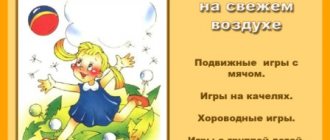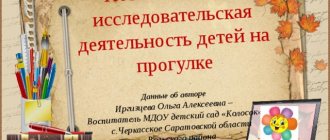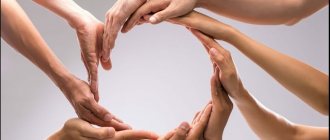Have a nice autumn day everyone! Tatyana Sukhikh is ready to talk with you again. Today I want to tell you how I observe the world around me while walking with my children. Using the example of a teacher’s work with your children, I hope you, parents, will gain techniques and ideas for meaningful educational walks in the fresh air.
As you already know from my articles or from independently obtained information, today in preschool institutions the educational process takes place mainly in the form of games. We use every moment to unobtrusively enrich the inner world of children and pass on new knowledge to them. Likewise, while staying in open areas or under a canopy in a pavilion during the rain, I always devote a little time to observations.
Since in kindergarten everything is done according to a plan and program, and not as the teacher comes up with, then such a developmental method as observation is planned in advance. I usually plan a new observation every day for a week according to the time of year. Today, for example, we study plants, tomorrow we study inanimate nature, then we observe people, etc.
Below I will describe in detail topics for conversation with children. In the meantime, let’s think together: why do you need to engage in a kind of spying on the world around you? Is it really necessary to pay such attention to this seemingly simple method?
I want to tell you that observation is one of the forms of active knowledge of nature and everything that surrounds us. Children gain impressions, gain personal experience, learn to love and understand everything around them. Observing is not as simple as we adults imagine. You need to be able to focus your attention and hold it. A colossal thought process occurs during which the child's mind processes a lot of information.
For example, one of the points in the plan for “spying” on people is to analyze what passers-by, children from other groups, etc. are wearing. By the way, about clothes, I will recommend you good online stores.
For little fashionistas and fashionistas
I found the website of our Russian manufacturer - the trademark “Lacy wear”. I have already looked at good things for my son, a good store with reasonable prices. Here you can buy everything from socks and T-shirts to winter jackets.
An excellent section of children's knitwear - hats, underwear, pajamas. St. Nicholas Day and New Year are just around the corner, so it’s time to start looking for gifts under your pillow and Christmas tree!
Yes, have you ever ordered goods from Ali Express? Good reviews about this store, high quality products, reasonable prices. Here you will find clothes for newborns and teenagers. Delivery is carried out in a short time and seems to be free. If anyone has ordered from these sites, please tell us!
Let's help each other and tell us where to cheaply dress our children? Where do you stock up on clothes for yourself and your children, and how do you get out? Winter shoes are especially expensive now, maybe someone has found inexpensive but decent shoes?
Although we have heard since childhood that we should not judge a person by his appearance, at the same time we were taught to be neat and tidy. What can you do, but clothes always work on a person’s image. When describing a person as we see him, we definitely pay attention to the “shell” - a coat, a hat... But it’s time to get down to business.
How do we observe the world around us with children in kindergarten?
As for planning, I do it monthly, writing out what we will do every day of the week during our walk. It looks something like this:
- Monday: observing wildlife - plants, trees, bushes, seeds, leaves, flowers.
- Tuesday: we observe inanimate nature - the sun, sky, clouds, wind, rain, etc.
- Wednesday: we notice the habits of animals, insects, birds, fish.
- Thursday: we look at how people work, what they do, and what they look like.
- Friday: we observe the environment, go on excursions around the territory of the kindergarten or nearby - a school, park, store, puppet theater, etc.
Why do I advise parents to plan joint activities with their children? If you sketch out a simple plan for yourself to do every day, you will not forget what you were going to do. And instead of chatting the entire walk with your neighbor on a bench, watching your child from afar, you will focus on his development.
Depending on the time of year, I focus children’s attention on characteristic changes in the world around them.
So, if you choose the topic of observation – “people”, then I’ll tell you how we do this in the fall.
So, September: I tell the children that they are finishing harvesting in the fields, that now is the season for apples, grapes, and vegetables. I ask the guys to tell us what they like from seasonal vegetables and fruits.
Yes, I didn’t say that one walk shouldn’t cover many different aspects of our life. Let's say we talked about the harvest and vegetables and that's enough.
Next time, pay your child’s attention to the fact that the leaves are falling, who cleans them up, and where they go later. You can take a rake and work a little with your child. Let him understand that the work of a janitor is not easy. It is appropriate to choose thematic riddles about autumn, harvest, etc.
Also in September we talk and observe schoolchildren, because the school year has begun. We look at what the schoolchildren are wearing, where they hide their textbooks and notebooks, and note that younger schoolchildren go to school with their mother, and older ones go to school on their own.
Planning walks in the middle group according to the Federal State Educational Standard
Let's look at the file of observation walks for the middle group of preschool educational institutions. In order for the walks to be interesting and at the right pace, it is necessary to draw up a plan and preliminary preparation on various topics.
Walk 1 – Autumn Tree Watching
Goal: learn to find distinctive features of trees in autumn compared to summer. To see extraordinary beauty in the autumn colors of trees.
Progress of observations: read the poem by A. S. Pushkin “Dull Time”.
Observe different trees with children. Find differences and similarities in the color of autumn leaves of oak, maple, birch, and rowan. Draw children's attention to the special beauty of the entire landscape in autumn, September, October, November.
Experience, experiment: collect beautiful autumn leaves for crafts on an autumn theme.
Outdoor game: competition with autumn fruits. Divide the children into two teams. Give each person one acorn (to the first team) and one chestnut (to the other team). From the beginning of the game, children from each team simultaneously run a race with their acorn (chestnut) to the marked place and throw it into the bucket. Those who run faster win. Physical exercise and reaction to speed will charge children with vigor and fun.
Walk 2 - Watching Snow During the Winter Months
Goal: learn to observe changes in nature in winter.
Progress of observations: note if snowfall means warming. Snowflakes crunch underfoot - frost. In winter it gets dark early - especially in December. In winter comes New Year and Christmas. Children sled, skate, ski, and play snowballs.
Experience, experiment: carrying out an analysis - measure the depth of a snowdrift in the sun and in the shade, offer independent activity to the baby.
Outdoor game: snowball fight. An active, cheerful game will warm children, give them a good mood, and teach them accuracy.
Walk 3 - watching a cat in the spring area of the garden
Goal: remember the characteristic signs of a cat, its habits, behavior.
Progress of observations: read a poem about a cat, ask a riddle and ask which of the children knows poems about cats. Invite children to examine and describe the cat and its distinctive features. Talk about how spring affects cats (they become goulens). That with the arrival of spring, the cat's fur sheds lighter for the summer period. Build a dialogue with children in the form of a conversation.
Experience, experiment: try to play with a cat using a ribbon on a string. Warn children that they should not pick up unknown animals on the street.
Outdoor game: conducting physical education. Jumping on two legs while moving forward. Moving exercises have a beneficial effect on muscles.
Walk 4 - observing flowers and insects in the flower beds in summer
Goal: find out how summer differs from other seasons. A thematic walk near flowering flower beds, carrying out a walk according to the planned outline.
Progress of observations: what flowers bloomed in the flowerbed, ask who knows what they are called, how the flowers differ from each other. Observing bees - how they pollinate flowers. Tell them how important their work is in nature. Ask children what insects they know, identify their differences and benefits for nature.
Experience, experiment: personal work: water flowers in flower beds from a watering can, telling children about the importance of watering plants.
Outdoor game: “Run to the flag.” Teach children to perform actions when signaled by the teacher. Quickly move to the flag and return back.
Planning walks for children in the middle group of kindergarten is a very significant moment in development. Observation walks have a huge positive effect on the entire children's team as a whole.
We observe the month of October
By the way, I can recommend to colleagues and parents a good teaching aid; you can buy it at UchMag - “Organizing children’s activities during a walk. Senior group". There are some great, comprehensive recommendations for observing the world around you here. You will find poems, games, riddles that can be used during educational activities in the fresh air.
So, in October we observe people like this: we pay attention to the fact that it has become colder, we see that people have begun to warm themselves, we look at the details of their clothing.
We also notice what kind of cars are driving, we talk about an ambulance, a fire truck, a police car. Let's take a look at what the overalls look like. Please note that people often burn fallen leaves, I explain that this is harmful to us and to the environment.
It is very important to talk to kids about how important it is to keep the streets clean and not to litter. You can sweep the area with the children, watch how the flower beds are cleaned and the plants are prepared for winter. In principle, observing people all year round comes down to looking at clothes, talking about different professions, seasonal jobs, etc. As you can see, it’s nothing complicated, but believe me, even short observation conversations have an extremely positive effect on the baby’s development.
The topic of observations is not exhausted, wait for the continuation. I remind you that subscription to news is open, please join us. If you liked my article, perhaps your friends on social networks will like it too.
Sincerely, Tatyana Sukhikh! Till tomorrow!
Organization of pedagogical observations in preschool educational institutions.
Organization of pedagogical observations of children’s inclusion
.
Observations are the process of following a child while he works or plays, without interfering with his activities. Purpose of observation: To provide ongoing assessment of each child's growth and development in order to plan activities that meet individual needs. Logging is the process of documenting observed activity. A systematic approach to monitoring children helps ensure the completeness of the data obtained, on the basis of which it is possible to draw up an individual plan for the child’s development for a given period.
By recording actions or their results, I have a record of what children do and how they do it, and I can better evaluate and set goals for that child. Over time, I can observe a child's behavior patterns, cognitive preferences, skill level, and developmental progress.
Observations should be objective and should not include what the teacher thinks or feels about what happened. It should include mainly what is done or said. To ensure objectivity, observations should be detailed and descriptive to contain as much information as possible. By looking at my observations, I can encourage and expand the interest shown.
There are different types of technology:
- Episode records are short descriptions of specific incidents. Verbal sketches.
- Diary notes are records of impressions of group and individual activities that are written at the end of each day.
- Observation map. It defines specific types of behavior and ensures a systematic process of collecting information about the child’s level of development in various areas. The map includes such areas as: social development, communicative development, information, active, health-saving
development.
The card contains information about what the child is currently interested in, what he can and cannot do in each area of development. I use this information to set pedagogical goals and create individual child development plans.
- A “portfolio,” or samples of work, is a collection of work that a child has completed over a period of time. They can include drawings, stories, photographs that reflect the child’s activities, and audio recordings of his speech. "Portfolio" is a very individual collection.
Here are some options for observing and recording your child's play and activities. Children should be observed in different group areas and outdoor areas at different times of the day throughout the year.
Observations of children are the basis for targeted planning and individualization of the program in accordance with the needs and interests of individual children and the group as a whole.
The choices children make on their own are usually developmentally appropriate. By reviewing my observations, I identify an area of concern or special interest and from there create an individualized development plan for the child.
Sometimes children express and realize their interests only at home, so it is necessary to involve parents in observing children in the home environment. When parents are asked about their consent to participate in the preparation of individual child development plans, it is necessary to make them understand that we expect their maximum cooperation with the family. This idea may be new to them and may not excite them at first. For parental involvement to become a reality and not be formal, it takes time to learn about the interests and capabilities of parents.
Studying the interests of parents allows us to inform about possible ways to help in drawing up individual plans and outline forms of their participation, taking into account personal inclinations, skills and abilities. It is unlikely that everyone will be equally involved, but each family's input is very valuable because it gives parents the opportunity to be more involved in their child's development and plan more accurately for their child's development.
Author: Ivanova Svetlana Nikolaevna


